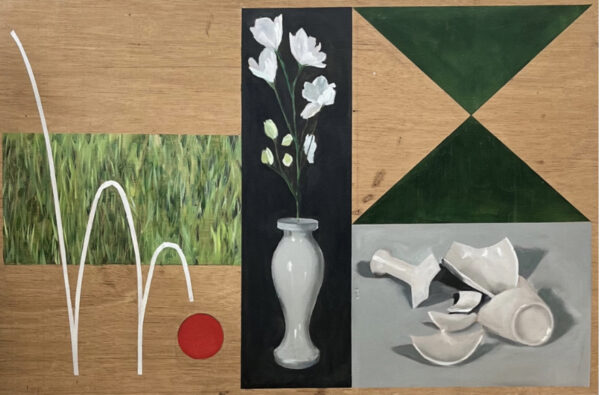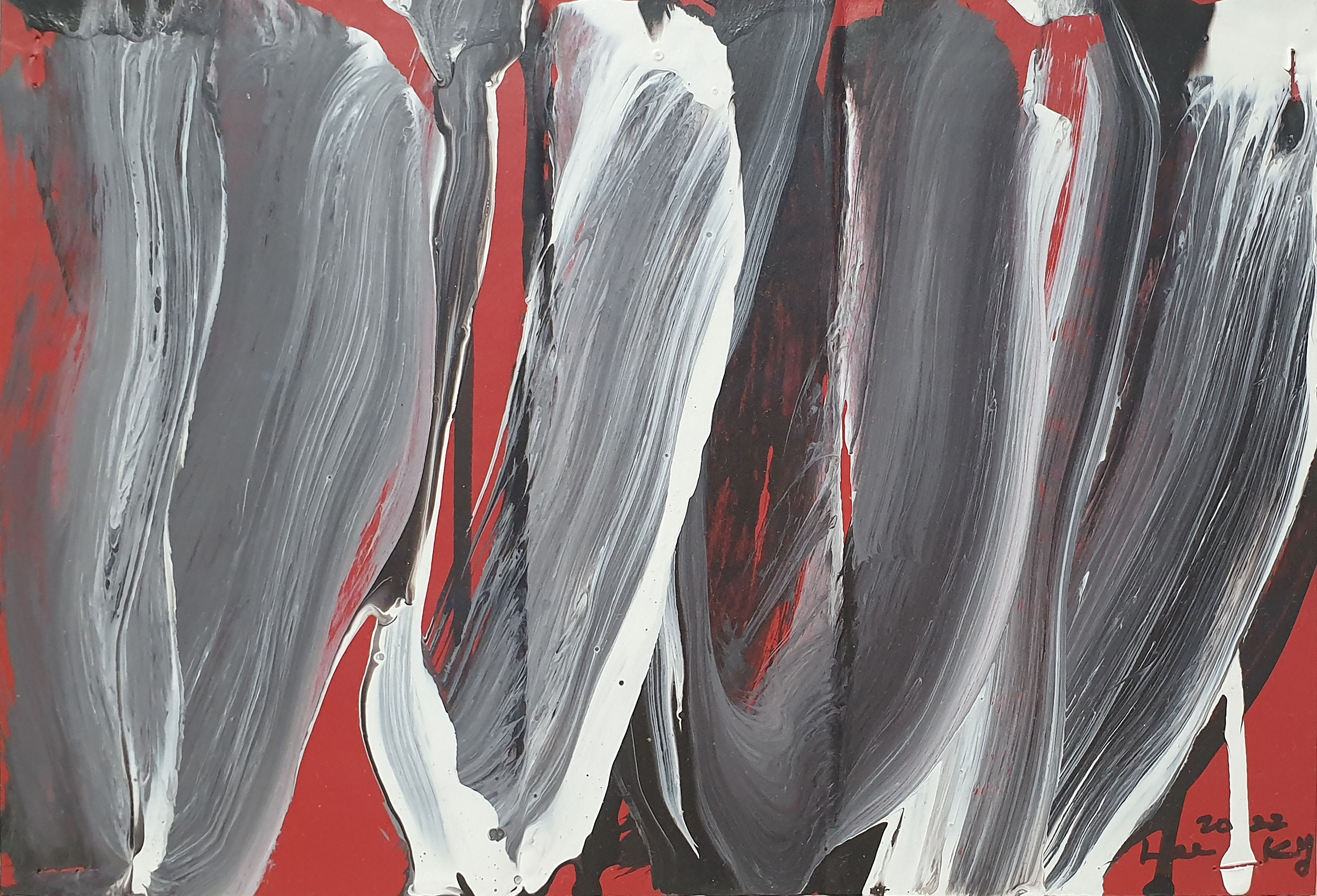The Gesture of Image
| [GALLERIES] PIBI GALLERY
2022. 8. 25 – 10.15
Dongju Kang, RohwaJeong, Jiyoung Yoon, Hyein Lee, Eun Chun

Since images has obtained meanings beyond the representation, they have taken on a polyphonic identity, shifting to a surface exploding with significance. Conceptual illustrations invade the realm of abstract senses and sentiments and, being intangible, perpetually stimulate memories, emotions, and thoughts in aspiration to achieve form. They attempt to capture attention with vivid visuals but dissipate as things simultaneously slip through the cracks of language or senses. Images may stand between a transparent visual system and a realm of expandable meaning but are built upon an unchanging genesis of creation: the artist and their gestures continue to be in motion. The value appraising of the completed surface, the image, is reset to the veiled starting points of the images, vibrantly evolving.
The Gesture of Image explores the basis established underneath an artwork’s image, i.e., the artist’s body and practices involved in the creation and production process. The show examines the “surface” – the work’s representing image – and the significance of the artist’s underlying gestures and physical fulfillments as the base that contributes to its meaning, thereby reassessing the artist’s position here and now as an individual derived thereof. For this, we approach the image by following the artist’s body, their actions, and the activities and trajectories of their motions that are overshadowed by the canvas, defining such veiled gestures of the creator as a distinct delivery avenue that initiates new interpretive opportunities. It is like understanding the image, an epidermis, with the artist’s body and a place of aggregated time and constructing a way for viewers to discover and assume their own gestures, all within the narrative structure of the exhibition’s time and space. The artist’s gestures bestowing rightful value to the produced image become included in the time and space of their body, eventually broadening into the current temporal and spatial issue where we meet other people.
The show pays attention to the bodies and gestures of the show’s participating artists and endorses them as unique tools of articulation and references of meaning for the artworks. Such bodily movements uproot the idea of a permanent image from an aspect of interpretation and present a multi-tiered reading that penetrates deep under its superficial layer. For example, the works of participating artist Hyein Lee are based on the sketch-from-life format. But rather than being replications of natural landscapes before her, they are more about exposing her body to an environment beyond control and putting to canvas the conflicts, harmony, conditions, and process of the experience. The endeavor entails everything from removing one’s self from the safety of the studio to the personal journey of finding a subject and transferring it to a surface. The procedural and environmental conditions, including accidental events, absorbed by the artist’s body conclude as a painted image, a pictorial interpretation, and an expression of the imagery and sentiments penetrated through the body and its senses that are constantly weighed down and reacting to the faced situation. The painting thereby acts one as circumstantial evidence of the artist’s body and senses, and two, as the occasion to verify and demonstrate the moment and time she existed as a painter. As such, Lee’s landscape expands beyond its initial spatial allowance of the canvas by stimulating viewers about various types of spheres in their memories, extending into the time, space, and even specific places of individuals.

On the other hand, RohwaJeong is a two-person team creating internal relationships that make formative interpretations and presentations of open-ended narratives or those that ask for third-party interferences to conclude. Their work departs from understanding their criteria of a medium, often embodying physical space and the specific locational value, and takes on an extraordinarily fluid and abstract format within the structure of an exhibition. For them, the exact configuration of the web of meaning – produced by a series of varied and multi-tiered significance that derive from artistic contemplation, the resulting object, and the audience’s appreciation of it – can be considered an artwork in itself. This show features their work, Between a and A, which consists of an action painting-like surface and video footage of the production process. RohwaJeong plays Ping-Pong with a paint-applied ball on a canvased table, leaving behind traces of the “process” created via a semi-controlled yet unique rhythm. The work calls to mind the myriad of relationships that exist in life, such as those with no winners or losers, absence of cause-and-effect, or without complete control.
Dongju Kang uses paper and pencil materials to document the environment around him. The way he represents his subjects is interesting, his created image leaning heavily on the abstract and the obscure. The artist focuses on the time it takes to observe his subjects, focusing not on their superficial form but on the moment he forms a relationship with them. Because Kang bases his work on the multi-angled perception discovered through the personal time and movements of his physical experiences, his resulting thin image is intimate with deep and dense layers of time. For this exhibition, he uses pencil and paper to depict his hometown in Seoul, night, and a walk by overlapping geolocation, time, and space while indiscriminately recording place and time. He faces spaces of daily life in their entirety, using time expanded from everyday life experiences and the body. And the profound and unique relationships formed with the subjects through repetitive action are the locational documentation that connects Kang’s and our time and space of then, there, now, and here.

Jiyoung Yoon specializes in the medium of sculpture, producing work that inquires about our system of perception, posing questions about things we see and believe, invisible matters that control our system of belief, and things that exist, however uncertain. Yoon’s work is seemingly obscure but is based on the logic built within her own system, earning its rightful value, significantly enough, not by the symbolic system of the surface-visible image but by the internal structure that supports that form. To make this possible, the artist removes the subject’s volume leaving only its external skin, or displays a planar figure on a surface to invoke the unidentifiable hidden virtual space under the outer layer of the work. The surface of a shapely figure and the form of some created space spread across the interior are visual phenomena. They are much like a sculptural body that activates a non-existing space. Ultimately to Yoon, an image is a fiction that shrouds the interior’s truth, and those things with no physical volumes or dissected planar figure sculpture pieces visualize the shortcomings of the trust and faith bestowed on visibility.

Last, we have Eun Chun, an artist who presents photography work that evokes the surrounding situation and environment through the subject. Her photos encompass the narrative that traverses the before and after moments of the captured instant, arousing, on a synesthetic level, even the unique time of the primary agent forming relationships with things beyond the created form. In this show, Chun features her early series that photographed the equipment foley artists and amateur astrologists use to achieve a sense beyond the visual perceptual level. Here, equipment refers to extensions of the body and the expansion of the primary user’s bodily senses. Their purpose and forms are difficult to ascertain just from their original functions and shapes. But combined with the specific intentions and actions of the performer, they become a medium that opens into a new realm of senses. The tool-user relationship brings one to accept the limitations of the bodily senses and imagine another sensory dimension simultaneously. As Chun’s photographs connect with the time-and-space senses beyond the recorded image the leading agent experienced, they trigger the fundamental question about the act of seeing itself. In addition, the relationship between such apparatus and the principal agent thus expands into the relations between the photograph and photographer Chun, who, as she faces the subject, leads us to imagine the other’s time beyond the phenomenon of the surface.

Moving away from the visual world created by the image, the surface, we examine the past hours of the creator and the layers and layers of interchanged time with others. Movements fashioned by paint and strokes; the hours of abyss formed by the blackened graphite; the imaginary dimension beyond the sense of sight departed from the form-enveloping skin; the unpredictable presentations of life suggested by paint spatters freely scattered on the canvas in the name of enjoyment; and gestures that expand the sensory world through a subject. This exhibition does not intend to halt at the superficial level of a finished image and regards the distinct attitudes of artists as the premise of meaning by showcasing their works spanning from their early to recent releases. Attitudes become format, which in turn achieves form. Through the fundamentals that determine an artwork’s style and shape, gestures that are begotten by the artist’s attitude, and the time they have encountered, we look at the surface, the images of the here, with a new perspective. Gestures relentlessly move in the same direction as the artist’s contemplations and inquiries while the image momentarily puts all that on pause to light up the place of the here and now. And in that manner, the artists’ gestures and hours of performance soon illuminate here with the image of the now, with hopes of expanding into some realm of other gestures via building relationships with others in this modest time and space of an exhibition.
PIBI GALLERY
125-6 Bukchon-ro, Jongno-gu, Seoul, Korea
+82 2 6263 2004











